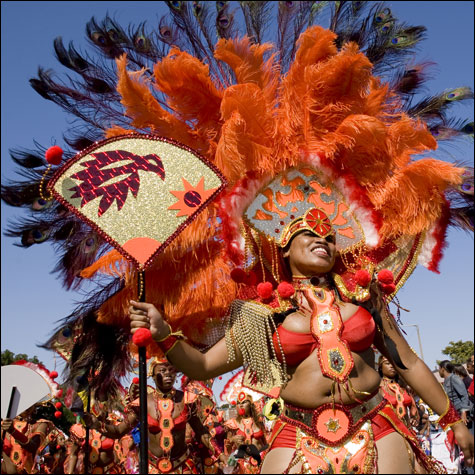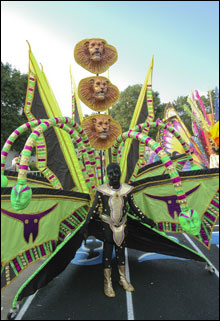
QUEEN, WARRIOR, SHOWGIRL: Smith’s subject matter outshines his technique, radiating
megawatts of color and fabulousness and sexy heat. |
The battery powering Michael C. Smith’s “Streets of Color” photography exhibit at Lesley University — and electrifying its subject, Boston’s Caribbean Carnival — is spectacle.In one photo, the queen of a mas (as in masquerade) band grooves down a street during the Carnival parade. Her swaying hands up, a smile across her face, she’s wearing an orange outfit, with gold boots, and giant green and orange wings and red plumes. Another shot shows a mas-band king as a riveting dream in black and gold, trailing great green flags, with green heads sprouting from the end of curving arms on his costume, and three lion heads scowling down from a pole. King and queen costumes rise as much as 15 feet tall — so big that they’re built as wheeled carts that hitch to the performers.
The exhibit’s 37 color photos from 2005 to 2007, plus three plumed headdresses, serve as an appetizer for the Carnival, which celebrates its 35th anniversary this month. The main event, the Carnival parade on August 23, offers streams of vividly costumed, scantily clad masqueraders shaking their booties to DJs and steel-drum bands playing soca and calypso plus some spooge, reggae, salsa, and zouk.
Smith, who lives in Milton, has photographed the festival since 1983. He’s an electronics engineer who grew up in Trinidad before moving to Boston in 1977. He’s served on the event’s organizing committee, the Caribbean-American Carnival Association of Boston.
Here he presents photos of costume designers paired with shots of their sketches, images of teams of dancers, a shot of a girl with her face painted with pink and orange butterfly wings. His best photo is a monumental shot of a monumental woman in a red bikini, beaded epaulets, and a crown decorated with orange plumes, red pompons, and peacock feathers. An army of similarly dazzling women follow behind. Smith photographs their leader from below, giving her an epic look — part queen, part warrior, part showgirl.
This great photo is a bit of an exception in the group; Smith tends to be an average documentary photographer. His prints (some of which are pixelly) are more interesting for what he shows than for how he shows it. But what he shows is astonishing — troupes of costumed paraders decked out like Day-Glo butterflies or tropical birds. They radiate megawatts of color and fabulousness and sexy heat.

KING: Anyone can be a ruler at Carnival time. |
“When the Carnival costume is finished and you see it out there, you think you’re in Las Vegas,” Ken Bonaparte Mitchell, the founder of the Boston Carnival, tells me when I call him at his home in Jacksonville. “They never went to art school. They had no professional training. They invented it themselves.”The Boston Carnival is part of a tradition that has spread across the Caribbean, North America, and Europe. It arose from the parties of 19th-century French plantation owners in Trinidad as well as celebrations by African slaves there after they were emancipated in 1833. One photo shows a woman from the Mudd Band slathered in mud — a tradition said to trace back to freed slaves imitating the French colonists who had imitated them in a sort of mud blackface. Smith: “I think when you look at where it came from, as best as I can tell, we started playing this Carnival or putting on these costumes by mimicking the slave masters. When they had their masquerade ball, these people would be looking in the window.”
The Carnival also has roots in the Catholic tradition of drinking and eating and dancing too much, of generally letting loose (think Mardi Gras), before the Lenten period of ritual fasting and prayer that precedes Easter. (In Trinidad, Carnival is celebrated on the two days before Ash Wednesday, but in deference to Boston’s chillier weather the local festival is held in August.)
Mitchell says he immigrated to Boston from Trinidad in 1968, at the outset of a large influx of Caribbean people to this area. “The economic situation back home was not very good. People wanted to explore better job opportunities, better education opportunities.” By the early ’70s, he was living in Dorchester and working as senior security coordinator for Boston public-housing developments. And he helped Caribbean immigrants become citizens and buy homes and find work. He helped organize various city fairs and community events. In 1972 he was invited to be a judge at the West Indian Carnival in Brooklyn.